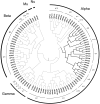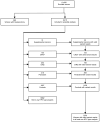A population-based prospective study of carcinogenic human papillomavirus variant lineages, viral persistence, and cervical neoplasia
- PMID: 20354192
- PMCID: PMC2855741
- DOI: 10.1158/0008-5472.CAN-09-4179
A population-based prospective study of carcinogenic human papillomavirus variant lineages, viral persistence, and cervical neoplasia
Abstract
Human papillomavirus (HPV) types differ profoundly in cervical carcinogenicity. For the most carcinogenic type HPV16, variant lineages representing further evolutionary divergence also differ in cancer risk. Variants of the remaining 10 to 15 carcinogenic HPV types have not been well studied. In the first prospective, population-based study of HPV variants, we explored whether, on average, the oldest evolutionary branches within each carcinogenic type predicted different risks of >2-year viral persistence and/or precancer and cancer [cervical intraepithelial neoplasia grade 3+ (CIN3+)]. We examined the natural history of HPV variants in the 7-year, 10,049-woman Guanacaste Cohort Study, using a nested case-control design. Infections were assigned to a variant lineage determined by phylogenetic parsimony methods based on URR/E6 sequences. We used the Fisher's combination test to evaluate significance of the risk associations, cumulating evidence across types. Globally, for HPV types including HPV16, the P value was 0.01 for persistence and 0.07 for CIN3+. Excluding HPV16, the P values were 0.04 and 0.37, respectively. For HPV16, non-European viral variants were significantly more likely than European variants to cause persistence [odds ratio (OR), 2.6; P = 0.01] and CIN3+ (OR, 2.4; P = 0.004). HPV35 and HPV51 variant lineages also predicted CIN3+. HPV variants generally differ in risk of persistence. For some HPV types, especially HPV16, variant lineages differ in risk of CIN3+. The findings indicate that continued evolution of HPV types has led to even finer genetic discrimination linked to HPV natural history and cervical cancer risk. Larger viral genomic studies are warranted, especially to identify the genetic basis for HPV16's unique carcinogenicity.
(c)2010 AACR.
Figures


Similar articles
-
Human papillomavirus (HPV) genotypes in women with cervical precancer and cancer at Kaiser Permanente Northern California.Cancer Epidemiol Biomarkers Prev. 2011 May;20(5):946-53. doi: 10.1158/1055-9965.EPI-10-1267. Epub 2011 Mar 17. Cancer Epidemiol Biomarkers Prev. 2011. PMID: 21415357 Free PMC article. Clinical Trial.
-
Human papillomavirus genotypes in cervical intraepithelial neoplasia grade 3.Cancer Epidemiol Biomarkers Prev. 2010 Jul;19(7):1675-81. doi: 10.1158/1055-9965.EPI-10-0251. Cancer Epidemiol Biomarkers Prev. 2010. PMID: 20615885 Free PMC article. Clinical Trial.
-
Human papillomavirus type 16 infections and 2-year absolute risk of cervical precancer in women with equivocal or mild cytologic abnormalities.J Natl Cancer Inst. 2005 Jul 20;97(14):1066-71. doi: 10.1093/jnci/dji186. J Natl Cancer Inst. 2005. PMID: 16030304
-
Risk of CIN3 or worse with persistence of 13 individual oncogenic HPV types.Int J Cancer. 2019 Apr 15;144(8):1975-1982. doi: 10.1002/ijc.31883. Epub 2019 Jan 10. Int J Cancer. 2019. PMID: 30246864
-
Impact of human papillomavirus types on uterine cervical neoplasia.J Obstet Gynaecol Res. 2024 Aug;50(8):1283-1288. doi: 10.1111/jog.15995. Epub 2024 Jun 9. J Obstet Gynaecol Res. 2024. PMID: 38852606 Review.
Cited by
-
Prevalence of HPV 16 and HPV 18 lineages in Galicia, Spain.PLoS One. 2014 Aug 11;9(8):e104678. doi: 10.1371/journal.pone.0104678. eCollection 2014. PLoS One. 2014. PMID: 25111834 Free PMC article.
-
Integrated genomic and molecular characterization of cervical cancer.Nature. 2017 Mar 16;543(7645):378-384. doi: 10.1038/nature21386. Epub 2017 Jan 23. Nature. 2017. PMID: 28112728 Free PMC article.
-
Human Papillomavirus (HPV) Infections and the Importance of HPV Vaccination.Curr Epidemiol Rep. 2015 Jun;2(2):101-109. doi: 10.1007/s40471-015-0039-3. Epub 2015 Mar 26. Curr Epidemiol Rep. 2015. PMID: 27500080 Free PMC article.
-
The contribution of Latin American research to HPV epidemiology and natural history knowledge.Braz J Med Biol Res. 2020 Jan 31;53(2):e9560. doi: 10.1590/1414-431X20199560. eCollection 2020. Braz J Med Biol Res. 2020. PMID: 32022103 Free PMC article. Review.
-
Co-infection with HPV types from the same species provides natural cross-protection from progression to cervical cancer.Infect Agent Cancer. 2014 Aug 12;9:26. doi: 10.1186/1750-9378-9-26. eCollection 2014. Infect Agent Cancer. 2014. PMID: 25152769 Free PMC article.
References
-
- Schiffman M, Herrero R, Desalle R, et al. The carcinogenicity of human papillomavirus types reflects viral evolution. Virology. 2005;337:76–84. - PubMed
-
- Schiffman M, Castle PE, Jeronimo J, Rodriguez AC, Wacholder S. Human papillomavirus and cervical cancer. Lancet. 2007;370:890–907. - PubMed
-
- Kovacic MB, Castle PE, Herrero R, et al. Relationships of human papillomavirus type, qualitative viral load, and age with cytologic abnormality. Cancer Res. 2006;66:10112–9. - PubMed
-
- Ho GY, Bierman R, Beardsley L, Chang CJ, Burk RD. Natural history of cervicovaginal papillomavirus infection in young women. N Engl J Med. 1998;338:423–8. - PubMed
-
- Rodriguez AC, Schiffman M, Herrero R, et al. Rapid clearance of human papillomavirus and implications for clinical focus on persistent infections. J Natl Cancer Inst. 2008;100:513–7. - PMC - PubMed
- Bouvard V, Baan R, Straif K, et al. A review of human carcinogens--Part B: biological agents. Lancet Oncol. 2009;10:321–2. - PubMed

